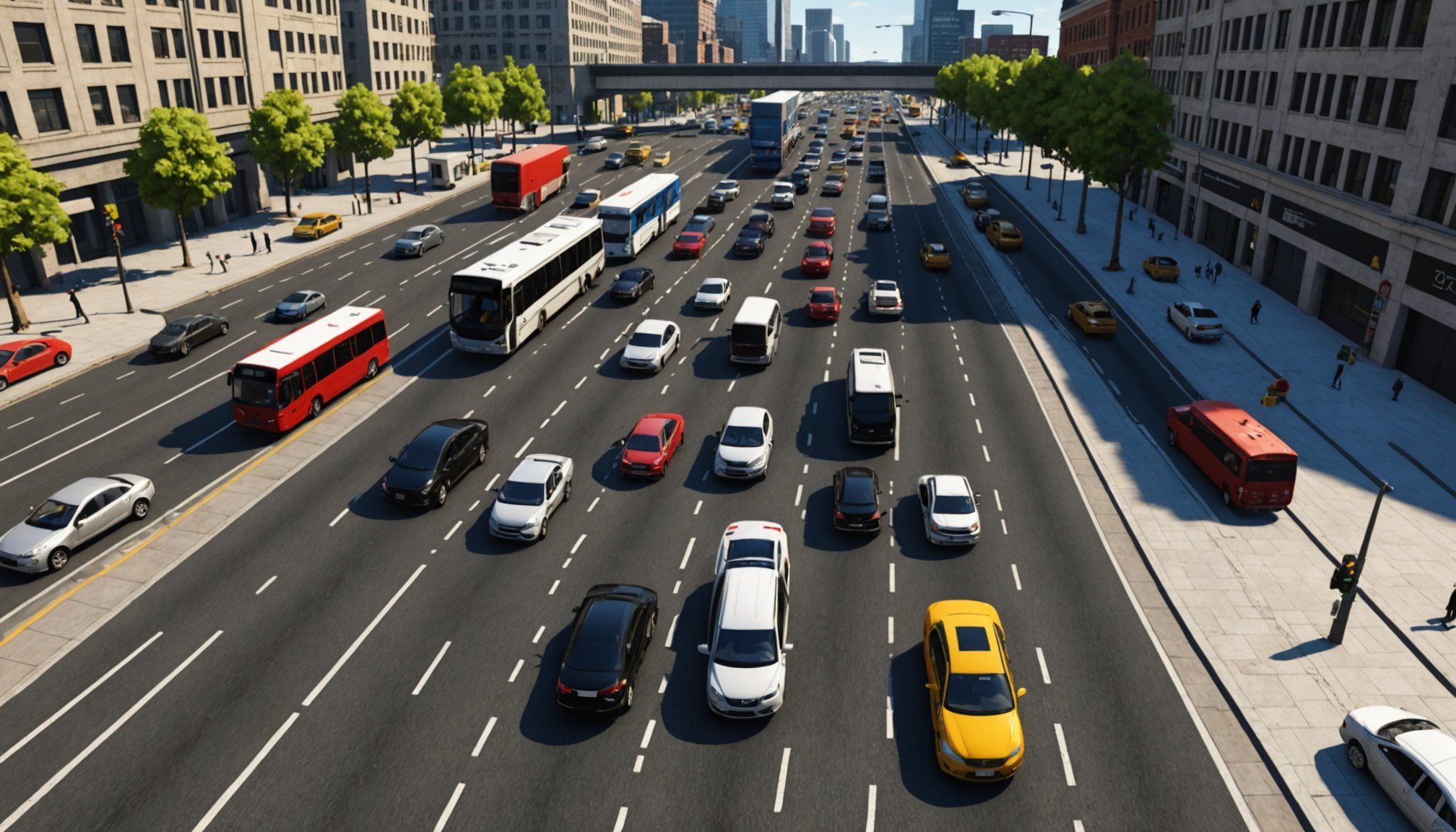Advanced Strategies for Traffic Flow Design
Creating realistic traffic flow in city simulation games is crucial for enhancing gameplay. One notable characteristic of authentic traffic flow is the simulation’s ability to replicate real-world traffic patterns. This involves accounting for peak hours, variable traffic densities, and diverging road networks.
The importance of modeling these patterns lies in delivering an engaging and believable user experience. Disruption in flow can lead players to disengage, highlighting the need for optimal design. By utilizing techniques such as dynamic pathfinding algorithms and adaptive signal systems, designers can optimize routes and reduce congestion.
Techniques to optimize traffic flow include:
- Dynamic traffic signal timing: Adjusting signal timings in response to traffic density helps maintain smooth flow.
- Pathfinding algorithms: These ensure that vehicles and pedestrians follow realistic and efficient routes.
- Congestion management strategies: This includes variable lane allocation and bypass routes.
By paying close attention to these factors, simulation developers can significantly improve gameplay enhancement. Moreover, integrating user feedback into the simulation design can yield further improvements, ensuring a continued balance between challenge and enjoyment. Capturing the essence of urban traffic systems can transform a regular simulation into a living, breathing city.
Behavior Modeling in City Simulations
Simulating realistic traffic dynamics in city simulations hinges on effective behavior modeling. By integrating sophisticated AI models, developers can create nuanced driver and pedestrian behaviors reflective of real-world interactions. Imagine a bustling urban scene where cars exhibit naturalistic lane changes, or pedestrians jaywalk in random yet plausible scenarios. Such AI integration enriches the fabric of simulated urban life, significantly enhancing immersion.
Behavior modeling involves setting parameters that dictate how traffic entities react to environmental stimuli. Vehicles may adjust speeds in response to traffic signals or avoid collisions by predicting others’ movements. Similarly, pedestrian AI can navigate crosswalks and adapt to changing traffic light patterns, influencing the flow organically. Such detail is crucial to maintain consistent traffic dynamics and prevent bottlenecks.
Incorporating AI integration into traffic simulations goes beyond mere tactical pathfinding. It comprehends anticipatory actions that drivers and pedestrians might take based on traffic density and typical human behavior. Some games use neural networks to refine these interactions, allowing systems to learn from prior simulations. This enhances realism and creates authentic gaming environments, offering players a convincing surrogate for real-world cityscapes. By mastering these techniques, developers can transform city simulations into captivating, dynamic experiences that mimic the chaos and order of real life.
Intersection Design Best Practices
Creating effective intersection design is paramount for ensuring smooth traffic flow and pedestrian safety. Well-structured intersections prevent congestion and accidents by aligning with strategic traffic engineering principles. Effective intersection design incorporates traffic signals that adapt to traffic volume, reducing wait times and improving flow efficiency. Synchronised lights can minimise stop-and-go waves, enhancing overall traffic dynamics.
Fundamental Design Principles
Intersection design is more than placement of traffic signals. It requires a holistic approach, accounting for both vehicle and pedestrian dynamics. Incorporating features like pedestrian islands or crosswalk signals ensures safety and fluidity. By considering the natural flow of traffic and routes, these elements can drastically lower accident rates.
Case Studies of Effective Intersection Design
Across city simulations, intersections may be modelled after real-life successes. For instance, roundabouts can provide continuous flow for vehicles while incorporating pedestrian pathways, reducing potential for accidents. Case studies often showcase these designs as guides for creating intersections that can handle high volumes while maintaining pedestrian safety.
Common Mistakes to Avoid in Intersection Planning
Poorly timed traffic signals can disrupt flow and cause bottlenecks. Another common error is neglecting pedestrian pathways which can lead to pedestrian safety hazards. To address these issues, developers should adjust designs based on simulated user feedback, refining traffic and pedestrian interactions for optimal gameplay enhancement.
Integrating AI for Enhanced Traffic Systems
Incorporating AI traffic management into simulations significantly transforms urban digital experiences. These adaptive systems mirror real-world complexities, enhancing the credibility of cityscapes in games. Real-time simulations leverage AI to adjust traffic dynamics based on fluctuating conditions, creating a fluid gaming environment. This results in less congestion and a more engaging experience for players.
AI techniques such as machine learning analyze traffic patterns and make strategic adjustments. For example, AI-driven traffic signals can adapt timings to accommodate varying traffic densities, facilitating seamless flow. These adaptive systems also preempt congestion by redirecting traffic and optimizing routes.
Several games exemplify the successful implementation of dynamic traffic systems. By simulating the unpredictability of real-world traffic, these games enhance realism and player immersion. Players benefit from witnessing organic movement within cities, thanks to AI’s ability to predict and react in real-time.
The benefit of adaptive AI in traffic simulations is twofold: it not only elevates the gameplay experience by making cities more lifelike but also helps developers iterate more efficiently based on player interactions. This ongoing refinement process enhances the game’s authenticity and enjoyment, encouraging sustained user engagement.
Visual Aids and Data Analysis for Traffic Simulation
Utilising visual aids in traffic simulation plays a crucial role in enhancing player understanding and engagement. These aids, such as heatmaps and traffic flow diagrams, provide clarity on complex urban systems. They not only offer visual representation but also help players grasp the impact of their decisions on traffic patterns, making the gaming experience more intuitive and engaging.
Integrating data-driven design is essential for refining traffic models and improving the simulation experience. By analysing datasets with tools such as GIS and real-time analytics platforms, developers can identify congestion points and optimise traffic flow. This analytics-driven approach allows iterative improvements, ensuring systems are both realistic and challenging.
Powerful software like SimCity’s traffic simulation engine exemplifies the effective use of analytics in city simulations. These tools process player-generated traffic data, facilitating behavioural pattern analysis and identifying potential pitfalls. This results in more refined and realistic simulations, enhancing gameplay enhancement.
Using visual aids combined with robust data analysis tools ensures that city simulation developers can create intricate yet accessible traffic systems. This approach enriches the simulation by bridging the gap between complexity and user comprehension, delivering an engaging gaming experience.
Case Studies from Popular City Simulation Games
Examining city simulation games provides valuable insights into effective traffic system design. By analysing these games, developers can identify lessons from both successful and unsuccessful implementations, shaping the future of gameplay enhancement.
In “Cities: Skylines”, adaptive traffic flow mechanics allow players to adjust road layouts, manage public transport, and implement traffic policies. These traffic flow systems are praised for their realism and user engagement. Conversely, SimCity players have noted challenges with pathfinding and limited control over traffic signals, which sometimes disrupted the desired city simulation experience.
Case studies from these games illustrate the significance of user feedback. Developers have utilised player insights to refine traffic dynamics, ensuring systems balance complexity with accessibility. This iterative process leads to continuous gameplay enhancement, fostering more engaging simulator environments.
Key takeaways include the importance of replicating real-world traffic scenarios and providing user-friendly interfaces for traffic management. By integrating player insights into updates, developers can refine their simulations.
Successful implementations of traffic systems in city simulation games highlight the potential for dynamic user experiences that keep players engaged. Understanding what works and what entrenches challenges is crucial for future development in this genre, ensuring that urban environments remain both believable and enjoyable.
Common Pitfalls in Traffic System Design
Designing efficient and realistic traffic systems in city simulations is an intricate task fraught with challenges. One major pitfall is the risk of over-complexity. While realism is desirable, overly complex traffic models can overwhelm city simulation players, detracting from the overall experience. Balancing complexity with gameplay enhancement requires careful calibration of traffic dynamics to keep users engaged without making the game feel unwieldy.
In addition to complexity, unrealistic traffic behaviours can disrupt engagement. Players often find themselves frustrated by erratic vehicle movements or impractical congestion patterns that deviate from expected traffic flow scenarios. It’s crucial to root simulations in real-world traffic principles to prevent such immersion breaks.
Design pitfalls also extend to intersections, where negligence in planning can lead to simulation failure. Poorly designed interfaces or traffic signals that don’t adjust based on traffic density lead to frequent congestion and bottlenecks. Developers should incorporate responsive traffic systems to reflect real-time conditions and enhance player satisfaction.
Finally, maintaining an equilibrium between realism and enjoyment is essential. Striking this balance ensures players remain challenged yet not overwhelmed, ultimately fostering a rewarding simulation experience. It also highlights the importance of ongoing refinement through active player feedback.










